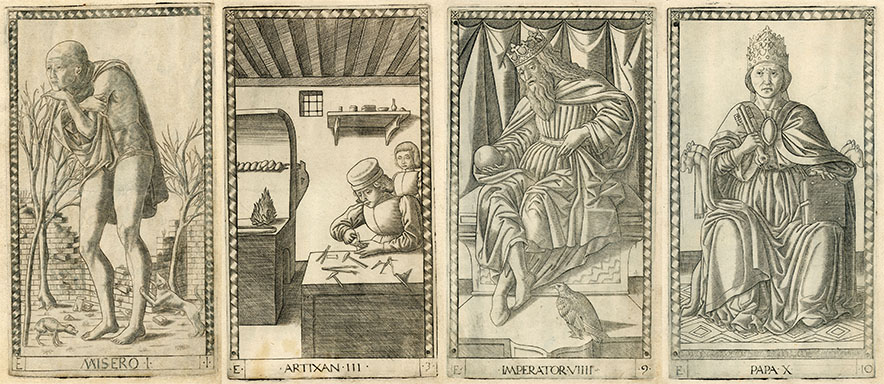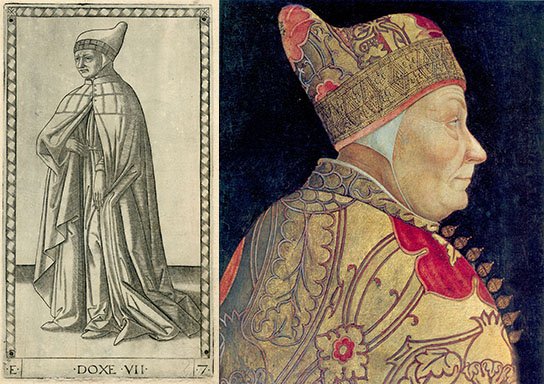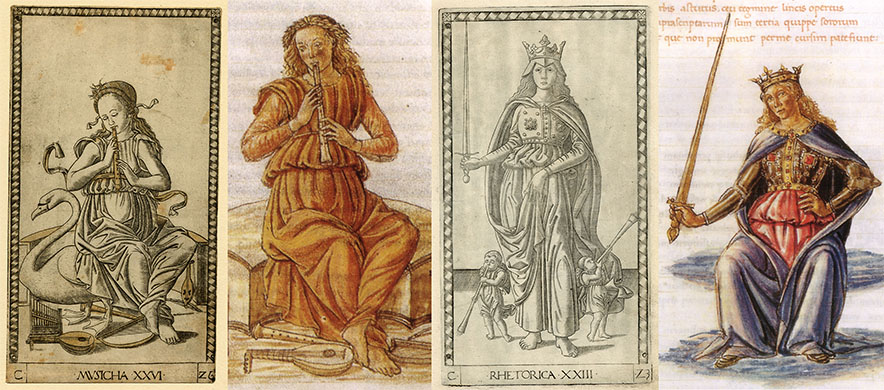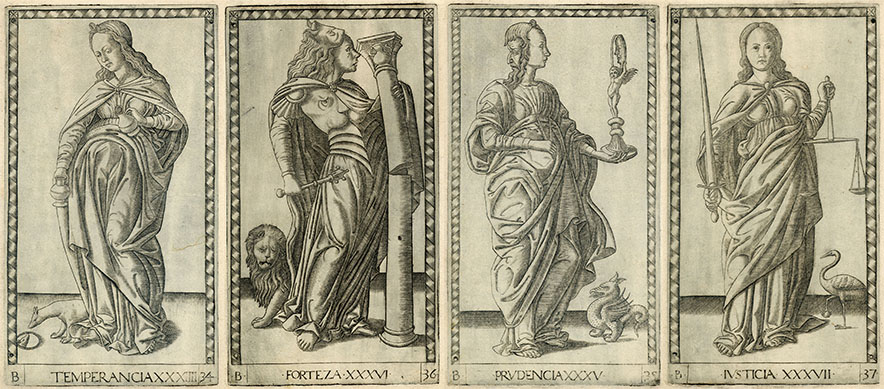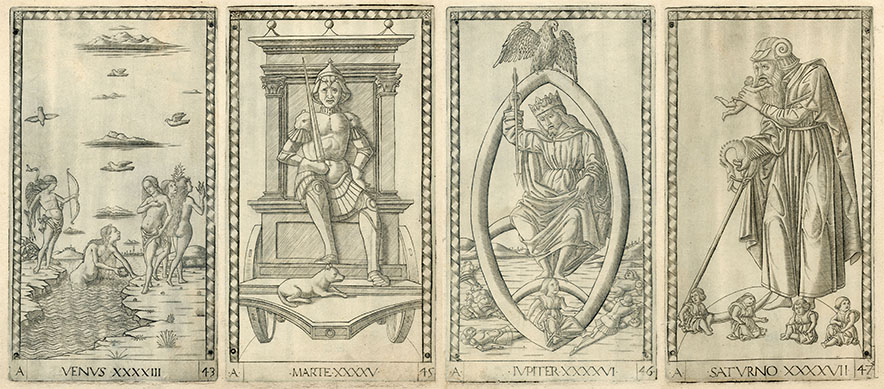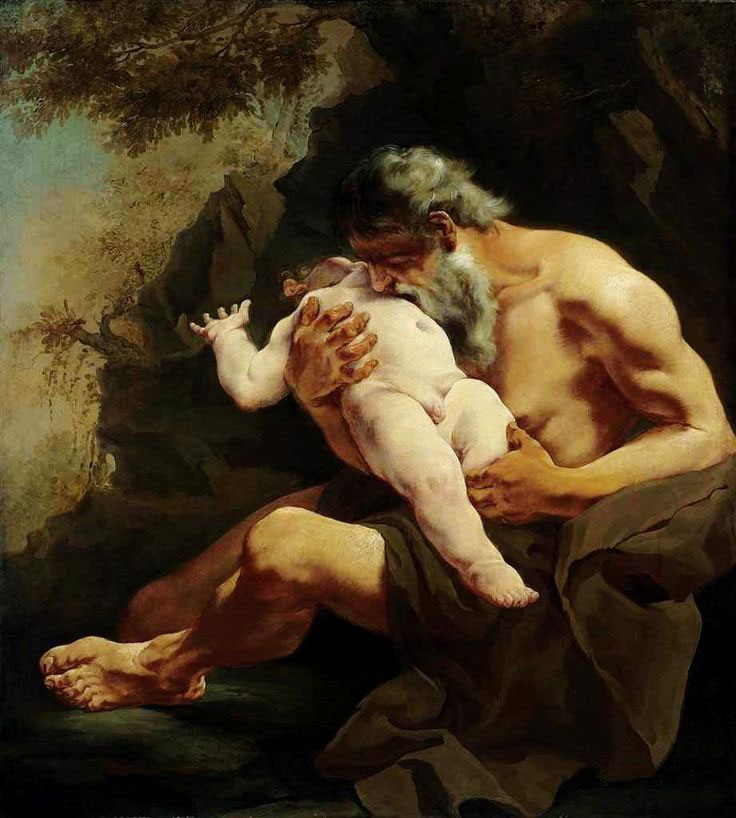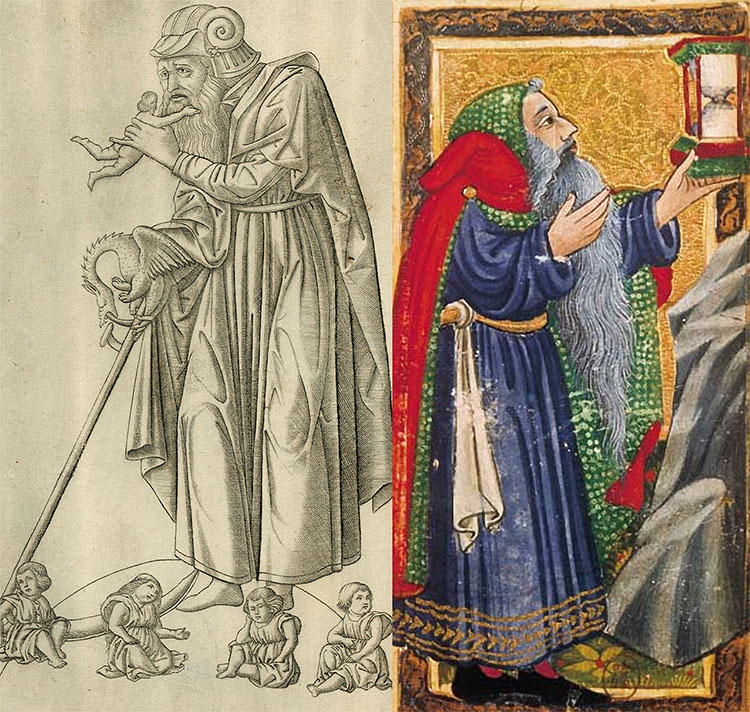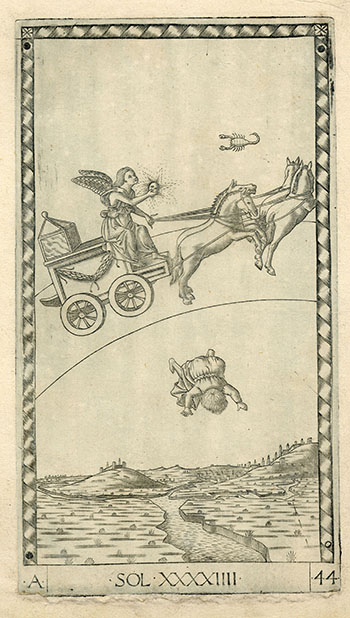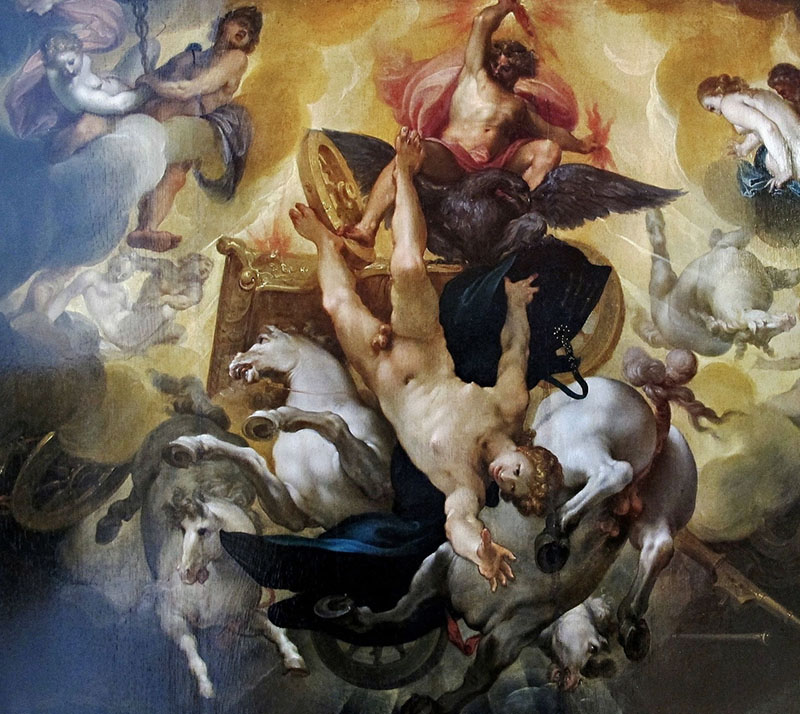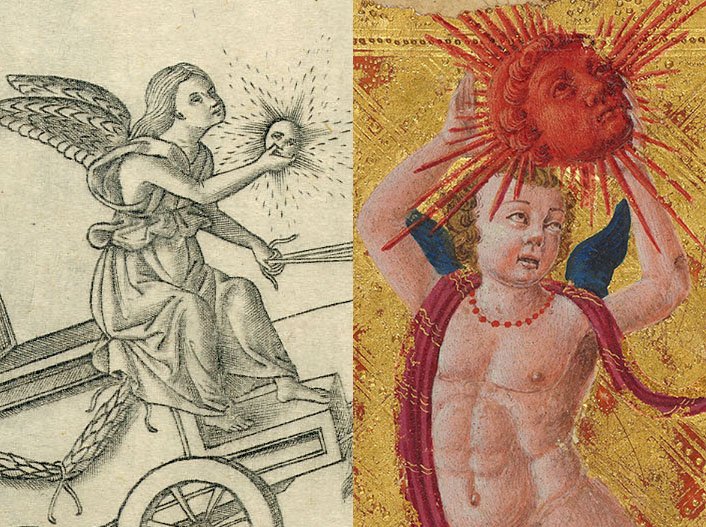THE TAROT WHEEL
THE MANTEGNA ENGRAVINGS
The so-called Tarot of Mantegna is not a Tarot game, it is not even a game, and it does not consist of cards. The Mantegna is a series of 50 engravings, maybe made with some educational purposes, probably created in Ferrara or Venice. What makes the Mantegna engravings interesting in the history of the Tarot is that these engravings represent a humanistic view on the World, very similar to the 22 trumps of the Tarot. The engravings have been created at the same epoch as the 22 trump structure and in the same area, Northern Italy. The engravings were attributed for many years to Andreas Mantegna, an artist and engraver born in Padova and working in Mantova for the ducal court. Most scholars do not believe anymore in this origin. Some prefer an origin from Florence, others attribute these engravings to Venice. Most of the experts attribute the engravings to an artist from Ferrara. Personally, I adhere to the group of people who think that the prints originated in Venice. We'll come back to this later on this page. There are two series of engravings, the so called E-series, dated to around 1465 and the S-series, dated to around 1470 to 1475. In fact, the S-series are a copy of the E-series and most of the cards have been engraved in mirror. The images shown on this page are all derived from the E-series conserved in the British Museum. The British Museum has a large collection of the Mantegna engravings, from as both the E-series and the S-series and from later engravings dated to 1530. You can find the images here. The objective of this page is not to give a thorough discussion of the Mantegna engravings, you can find many of them on the Internet. The main objective here is to present similarities between the Mantegna engravings and the Tarot cards and structure.
The Structure of the Mantegna engravings
The 50 engravings are grouped in 5 series of 10 cards. The lowest group of 10 cards is labeled E in the left bottom corner, the next group D and so on, until A for the highest group. In the bottom-right corner, we see a number from 1 for the lowest figure to 50 for the highest figure. Between these two identifications we find the name of the image with the number in Roman numerals (from I to XXXXX in additive writing). Like in the Tarot, the lowest group represents society and the highest group the ascent to God. The three groups in between have a different structure when compared to the Tarot trumps, they do not represent the hardship of human life, but the Muses, the Liberal Arts and the Virtues. The image here below represent four figures from the first group that have their counterparts in the Tarot trumps :
Without any difficulty we can recognize the Fool (MISERO), the Magician (ARTIXAN), the Emperor (IMPERATOR) and the Pope (PAPA). The Mantegna images in this group are male only, so the Popess and the Empress do not have a counterpart.
A very interesting image in this group, maybe pointing to the origin of the Mantegna engravings, is image 7, called DOXE. The card represents the Doge of Venice, the figure on the engraving looks like Francesco Foscari, who was Doge of Venice from 1423 to 1457. Francesco Foscari was a real hawk, and he was in war with the Duchy of Milan during 31 years. In 1454, he was defeated by Francesco Sforza, which led to the Treaty of Lodi, also known as the Peace of Lodi, signed between Milan, Venice and Florence. The card is placed between the Knight (CHAVALIER VI) and the King (RE VIII). If the images had been made in Ferrara, probably card number VII would have been depicted a Duke. Because a Doge has been represented here, I adhere to a Venetian origin of these engravings.
The second group of ten cards, labeled D, depicts the 9 Muses. Apollo heads this group as card number 20 (and XX). Four of the Muses are shown on the page of introduction, so I won't repeat them here. The Muses represent the pleasant parts of life.
Next to the Muses appears the C group, representing the seven liberal Arts. The seven liberal arts are divided in the Trivium (Grammar, Rhetoric and Logic) and the Quadrivium (Geometry, Arithmetic, Music or Harmony and Astrology or Cosmology). In the image here below we show two of these liberal arts, MVSICHA and RHETORICA, compared to illustrations of the seven Liberal Arts made by the Florentine painter Gherardo di Giovanni del Fora between 1474 and 1480. Gherardo is clearly inspired by the Mantegna engravings.
The Liberal Arts were an educational tool, with as objective to develop mental capacities. As such, they fitted very well in the Mantegna engravings. To complete the group of ten cards, Poetry, Philosophy and Theology were added to the original seven Liberal Arts.
The next level, labeled B, consists of the Seven Virtues. Three of the Virtues, Temperance, Strength and Justice are present in the Tarot, and all of them can be found in the Minchiate cards (see next page). Before the Seven Virtues, to arrive at ten cards, are depicted three Geniuses, Iliaco the Genius of Light, Chronico the Genius of Time and Cosmico the Genius of Space. The image below presents the four cardinal Virtues in the order given by Platon, Temperance, Strength, Prudence and Justice.
The next level, the A group, represents the ascent to God. We have the seven known "planets", the Moon, Mercury, Venus, the Sun, Mars, Jupiter and Saturn. The Planets are followed by the fixed stars, then an empty sphere clearly separating God and his creation and last but certainly not least the Cosmos, representing God. The similarities with the Tarot cards are evident. Look at the four cards represented here below. Venus has some details in common with the Lovers, Mars is very similar to the Chariot, Jupiter looks like the World on the Tarot of Marseille and Saturn is a strange blend of the Hermit and Death of the Tarot decks.
The Stories behind the Mantegna engravings
Many of the Mantegna cards, and probably all of them, tell a story. All symbols on the card are there to recall parts of this story. As an example, let us have a closer look at the card representing Saturn, a card that corresponds best to the Hermit (the Old Man, Father Time) in the Tarot deck. In fact, the card is called Saturn, the Roman God of Time, but on the illustration we see Cronos, the Greek God of Time. How can these two Gods be combined in one illustration? All myths, Greek as well as Roman, have many versions myths. Let me tell you one of the versions that explains the illustration:
In the beginning, there was Chaos, and Chaos ruled over the Universe. Out of Chaos alone, three children were born; Gaia, representing Earth, the first of the elements, Tartarus, representing the Underworld and Eros, representing Love. Out of the union between Chaos and Gaia, Uranus was born, the God representing the Sky. Still later, out of the union between Gaia and Uranus, many children were born. One of these children was Cronos, the God of Time. With the birth of Cronos, Time was created and so was the Universe as we know it today. But Uranus hated his children, and he banished them to Tartarus. This infuriated Gaia, and she asked her children to overthrow Uranus. The only one who was ready to do so was her youngest son, Cronos. Gaia gave him a scythe, and with this scythe Cronos castrated his father and took his place as ruler over the Universe. Uranus predicted that Cronos would leave this position in the same way as had conquered it, being overthrown by one of his children. Cronos had many children with his sister Rhea, such as Hades, Poseidon, Hera, Hestia and Demeter. To be sure that his father’s prevision would not become true, Cronos ate his children as soon as they were born. When Rhea expected a sixth child, she gave birth in secret to Zeus. Cronos asked Gaia for the newborn child to eat him. Instead of Zeus, Rhea gave him a stone with the appearance of Zeus. Cronos swallowed the stone without remarking the difference. When Zeus had become an adult, he secretly administrated to Cronos a substance that made him vomiting. First came out the stone, quickly followed by his two brothers and three sisters. Being immortal Gods, they could have stayed for millions of years in the stomach of their father without being killed. On his turn, Cronos was sent to Tartarus and from that day Zeus ruled the Gods. Cronos managed to escape from Tartarus to Italy, where he ruled as Saturn, the Roman God of Agriculture and Time. The Mantegna cards were created in Italy, so this is the reason why the card is called Saturn instead of Cronos.
On the illustration, we see Cronos devouring one of his children, with at his feet the other four children he will eat. In his hand, the scythe that he used to castrate his father Uranus. Also in his hand, an Ouroboros, a dragon eating its own tail. The Ouroboros is a symbol of time, cyclicity and of eternal recreation. Here the Ouroboros symbolizes Time, Chronos being the God of Time, but it also is a hint to the second birth of the children of Cronos when he vomited them. Here below an 18th Century interpretation of Cronos devouring his children painted by Giulia Lama.
Here below we see a comparison between the Mantegna card called Saturn (God of Time) and the contemporary Charles VI card also depicting Father Time. Both illustrations are believed to have been made around 1465, it is impossible to say which of the two is the older one.
heavens. Helios put a magic oil on the skin of the boy to protect him against the heat, and he also put the crown of light on the boy’s head. Then Aurora opened the curtains of Dawn, and the four mighty stallions sprung to Heaven, with in the Chariot Phaeton instead of his father. This ride was the wildest thing Phaeton ever had done. He was exited and deeply frightened at the same time. In the beginning he managed to lead the stallions. They passed the great snake, who, woken up by the heat of the sun, exhaled poisonous breath. Phaethon was terrified by now and wished that he had never made his stupid wish. Now the Chariot approached the giant Scorpion. The huge monster raised his tail to try to hit the boy. Struck by fear, the boy dropped the reins and the stallions galloped downwards instead of staying in the sky. The Chariot came closer and closer to Earth. Rivers dried up and forests caught fire. When the Chariot crossed the African continent, it was so close that the whole Sahara forest caught fire. The once so green and lovely forest was reduced to ash and burning sand, and the skin of the people in Africa blackened because off the terrible heat. All creatures begged Zeus for help, and even his mother Gaia (Earth herself) was afraid to be burned up. Finally, Zeus was obliged to send his mighty thunderbolt to destroy the Sun Chariot. The Chariot was destroyed and fell into the Sea. And also the boy fell down, wrapped in flames that burned him to death. The four horses escaped and ran home. The God Vulcan quickly made a new Sun Chariot, but Helios was so sad about his son’s death that he refused to drive this new Chariot. The next day was a day without sunlight. The other Gods begged Zeus not to leave them in darkness. Whatever Zeus said, Helios refused to ride again the Sun Chariot. For this reason, Zeus was obliged to ask his own son Apollo to ride the Sun Chariot. And from that day on, Apollo is riding every day in the skies. This is the real story of Phaethon, the story about how the Sahara Desert was created, why the African people are black and why Helios was replaced by Apollo, the story that is depicted on this Mantegna print. Here below a 16th Century interpretation of the fall of Phaeton by Heinz Jozef the Elder.
Let me give you a second example. Here at right, you see the card 44 representing the Sun, corresponding to the Sun in the Tarot deck. On the card, we see Apollo riding the Sunwagon. We also see a Scorpion in the sky and Phaeton, the son of Helios falling to the Earth. What is the story behind this card?
Long time ago, the Sahara was green and people were living and hunting in this beautiful land. Still today, you can find prehistoric drawings in the Sahara Desert depicting animals and hunters. So, our story starts long ago, when the Sahara was green and the great Gods were still existing. In that time, there was a handsome boy living in Ethiopia. Ethiopia is as you know the country where humanity has born, the cradle of mankind. This beautiful boy, who was called Phaethon, was the son of an Ethiopian woman and of the Sun God Helios, who was himself son of the Titans Hyperion and Thea. A friend of Phaeton was teasing him and saying that Phaethon’s mother was just telling foolish stories and that Helios was not his father. Phaethon was ashamed and asked his mother to give him a proof that he really was the son of Helios. Phaethon’s mother said to his son, “Go and ask himself, you can find him in his palace in the high mountains to the East”. Phaethon went for a long journey, through Arabia, Persia and India to finally arrive in the Himalaya mountains. And there he found the palace of Helios. In the palace there was a throne surrounded by the four Seasons. And on the throne was sitting Helios. Helios said, “Why did you come to me, Phaethon?”. And Phaethon replied, “Oh father, I need a proof that you really are my father”. Helios smiled and answered, “I really am your father. As a proof I will grant you one of your dearest wishes”. “Oh father” replied Phaethon, “let me replace you today and let me ride the Sun Chariot”. Helios immediately regretted he granted his son a wish. How he tried, he could not convince his son to change his wish. Helios was obliged to make the wish of Phaeton come true. He warned his son for the many dangers in the sky, and he advised him to stay in the middle path of the
The Visconti Sforza card the Sun has a big resemblance with the Mantegna card. Look at the comparison here below. On both illustrations, the winged figure is holding the Genius of Light, symbolizing the Sun, in his hands. What most people do not know is that the Visconti Sforza card is created after the Mantegna engravings. The Mantegna engravings are dated to 1465, at approximately the same time as the Charles VI Trionfi deck. 70 Cards of the Visconti Sforza deck (two of them are lost) were created around 1451-1454, maybe at the occasion of the Peace of Lodi. The remaining cards (including the Sun) were created by another artist approximately 20 to 30 years later, so well after the Mantegna engravings were printed. For more about this topic, see the pages about the Tarot Development.
The Mantegna engravings will always stay a mystery. We don't know with exactitude who made these engravings, when they were made; and where exactly. What we know is that they are contemporary to the development of the 22 trump structure, and that both of them give a very particular view on the organization of the Cosmos and human life. It is for sure that there has been an exchange, many debates probably, between the makers of the Mantegna engravings and the brains behind the 22 trump structure of the Tarot, of which Ercole I of Este, one of the best educated people of his time, might have been one. The similarities are too evident to be ignored.
